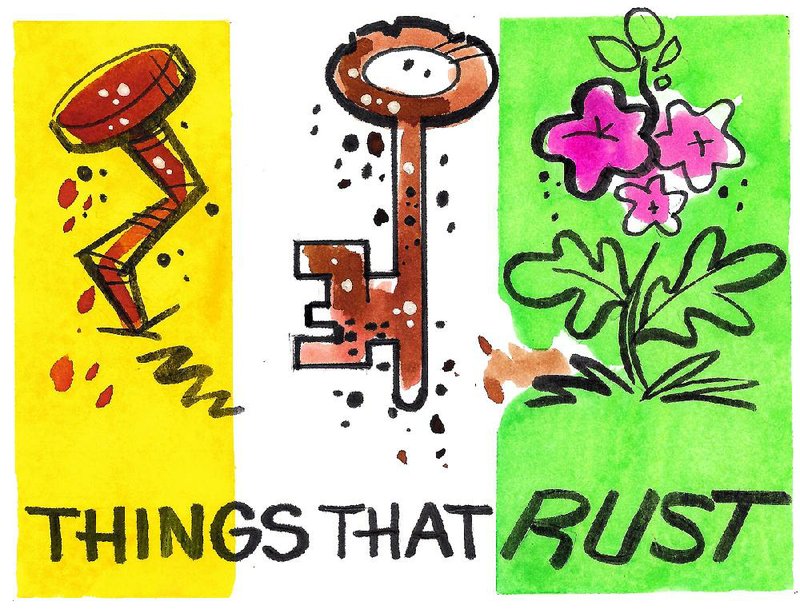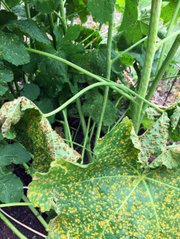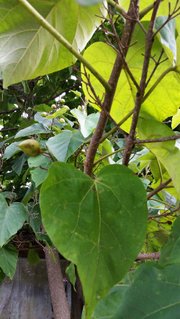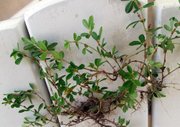Q I need help. My hollyhocks are dying at the base, and they have yellow spots all over them. Is it an aphid? What can I do to save them and stop the spread?
A I would say you have a bad case of hollyhock rust. Hollyhock rust tends to become more severe as the summer progresses, and has hit early this year with all the rain and humidity. When you have the disease on a plant, spores are carried to other plants by splashing rain and wind. Sanitation is critical. Clean up as many diseased plants as you can and spray your healthy plants with a product containing chlorothalonil (Daconil or Bravo) or myclobutanil (Immunox). This fall make sure you cut back all the old foliage to the ground and dispose of it. If you have had this problem in the past, be proactive and spray when the plants begin growing to prevent infection. Once you have a disease firmly entrenched in a garden it is hard to control it.
Q My irises and daylilies have "pods" on them. Can they be used for propagation?
A Irises and daylilies can be grown from seed, but in my opinion that is a fairly slow process to get a blooming plant. Plant breeders do crosses of daylilies, and that is how we get the new varieties -- from those seeds. You won't necessarily get plants that look like the mother plant from the seeds. To grow them from seeds, you need to allow the pod to mature, then plant the seeds separately. It usually takes two years before you see a flower. The tuberous roots of daylilies and irises can easily be divided if you need more plants. The babies will grow up to look like their mother, and they should bloom the next season.
Q I have two black lace elderberries about 10 years old. They have bloomed wonderfully every year, but thanks to my haphazard pruning over the years, the plants have a haphazard shape. The plants are 7- to 8-feet tall and about that wide, with each having several trunks ranging in size from a half inch to 2 inches in diameter. Can you give me some pruning ideas?
A You have a few options. You can thin out some of the older canes at the soil line and then lightly shape the ones you leave. Normally pruning is done after bloom, unless you are trying to grow the fruit. If you are treating the plant as an ornamental, you can enjoy its flowers and then prune next year, or you can do a little shaping now and the bulk next season. If your main goal is just the black foliage, prune it hard next year before growth begins. A little pruning can be done now but we are in the hot, dry part of summer and recovery will be slow. I would wait until a more accommodating season.
Q Attached are pictures of two plants: one a "mystery" tree we haven't identified; and the other of a weed that is taking over our centipede lawn. Can you help identify these species and tell how can we eradicate the weed from our lawn? Our neighbor has the same problem. We were told to use "weed and feed" and it would get rid of it. It didn't.
A The tree is one I get asked about frequently because it just "appears" in the garden. It is commonly called an empress tree or royal paulownia -- Paulownia tomentosa. It produces woody seed capsules that will pop open in the fall, scattering the seeds. Many of the seeds germinate, and when young, the tree can grow quite rapidly and have huge leaves. As it ages, the leaves become a more normal size. Then it will begin to produce beautiful clusters of purple blooms in the spring, followed by the woody capsules. It grows fast, has weak wood and thus falls apart with age. I classify it as a trash tree because of the aforementioned qualities, plus the fact that it can be somewhat invasive.
Your weed is lespedeza. This weed can be difficult to control, particularly in a centipede lawn since centipede is more sensitive to weed killers than are Bermuda or zoysia. When you have lespedeza in the lawn it often indicates you have insufficient nitrogen fertilizer. Two applications of a product such as Ortho Weed B Gon, applied at the rate for Southern grasses, is the best you can do. Apply 30 days apart, starting now, but watch the temperatures and don't apply it on a terribly hot day. It would have been better to do when it was a bit cooler.
Janet B. Carson is a horticulture specialist for the University of Arkansas Cooperative Extension Service. Write to her at 2301 S. University Ave., Little Rock, Ark. 72204 or email her at
HomeStyle on 07/15/2017




